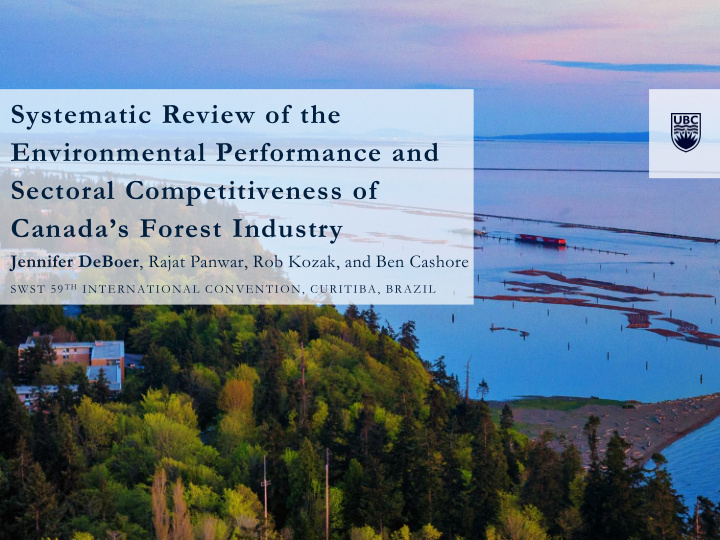



Systematic Review of the Environmental Performance and Sectoral Competitiveness of Canada’s Forest Industry Jennifer DeBoer , Rajat Panwar, Rob Kozak, and Ben Cashore SWST 59 TH INTERNATIONAL CONVENTION, CURITIBA, BRAZIL
BACKGROUND Canada’s forest products industry is an important economic engine ► Provides high quality employment ►Contributes significantly to Canada’s GDP ► Promotes community well-being Source: Natural Resources Canada, http://www.nrcan.gc.ca/forests/report/economy/16556 2
BASIC MOTIVATION FOR THIS RESEARCH How can a higher environmental performance help an industry to become more competitive globally? 3
CONTEXT ►Canada’s forest industry represents one of the most progressive examples of environmental stewardship ► Extensive research suggests higher environmental performance results in a competitive advantage ► Yet, empirical studies provides little evidence to support the claim that consumers reward firms based on their environmental performance 4
OBJECTIVE The primary objective of this systematic literature review is to strengthen our understanding of the link between environmental performance and industry competitiveness ► Specifically, we will: ► Consolidate extant literature ► Identify critical knowledge gaps ► Propose a future research agenda 5
ENVIRONMENTAL PERFORMANCE ► Two domains of environmental performance ► Regulatory dimension ► Voluntary dimension 6
ENVIRONMENTAL REGULATIONS ► The effect of environmental regulations on industry competitiveness ► Porter Hypothesis ►Environmental regulations enhance firms’ competitive advantage ► Management research ► Empirical results have been mixed ► Forestry research ► Research is scant but ambiguous ► How and when do environmental regulations lead to winning innovations 7
VOLUNTARY ENVIRONMENTAL ACTIONS ► The effect of firms’ voluntary environmental actions on industry competitiveness ► Management research ► Positive – brand reputation, consumer loyalty, risk management, market access, product differentiation ► Negative – increases cost of doing business ► Forestry research ► Positive – premium prices, market access ► Negative – consumers unwilling to pay premium prices ► How and when do voluntary environmental actions result in economic advantage? 8
METHOD ► Systematic Literature Review ► (unbiased) ► No protocols are available in the management or forestry literature ► We will follow the procedure in Kitchenham & Charters (2007) ► Step 1: Consult peers to develop comprehensive lists of keywords and appropriate journals ► Step 2: Use academic databases and logical connectors to conduct the keyword and journal search ► Step 3: Review the abstracts of all articles to identify studies to be used ► Step 4: Compare and synthesize findings based on articles pool 9
PRELIMINARY RESULTS ► Search parameters: environmental regulation keywords (19), voluntary action keywords (30), competitiveness keywords (29), management journals (31), forestry journals (17), environmental/sustainability journals (20), policy journals (12), and publication date (2005 – 2015) ► Preliminary search results = 1920 ► Abstract review search results ~ 475 ► Detailed review search results ~ 200 10
DISCUSSION & CONCLUSION ► Preliminary research issues ► Lack of data ► Inadequate proxies ► Causality ► Over the next two months, I will further refine our results, analyze relevant studies, and synthesize studies’ findings ► Ideally, this literature review will allow me to provide a comprehensive and objective overview of the linkages (a) environmental regulations and (b) voluntary environmental actions have with industry competitiveness. 11
ACKNOWLEDGEMENTS Social Sciences and Humanities Research Council & Natural Resources Canada - Knowledge Synthesis Grant Competition 12
Thank you! Jennifer.L.DeBoer@gmail.com
Recommend
More recommend